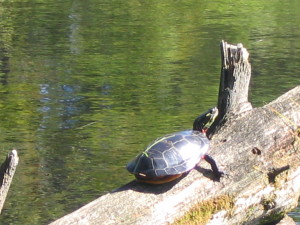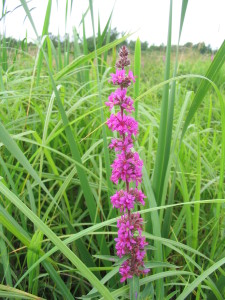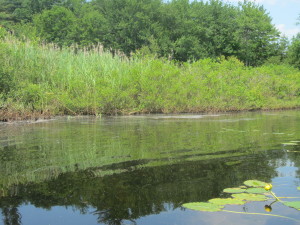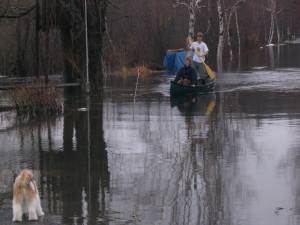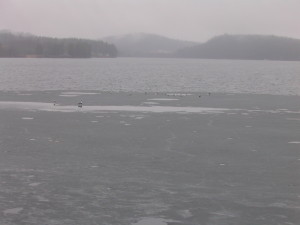by Dana Little, 6/25/13
Living on the pond’s edge, we occupy prime turtle habitat. Both the large snapping turtle, up to 20 inches long and 60 pounds, and the smaller, more colorful painted turtle thrive in Taylor Pond. At our house, every June, a female snapper emerges from the mud on the bottom of the pond, and appears on our lawn or driveway. She’s searching for a nesting site. Over several hours, she digs up spot after spot in the soft mulch of our gardens, before settling on the right one. There, she lays and buries 20-30 white eggs, about one inch in diameter. She returns to the water and often, within 24 hours, we find the location of her raided nest by the broken egg shells strewn about by a marauding fox, mink, raccoon, or skunk.
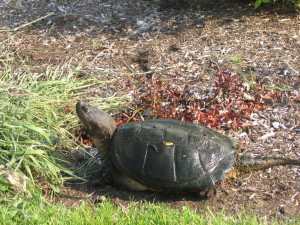
Mother Snapping Turtle searching for a nesting site.
Any remaining eggs will hatch in the fall. The sex of these little survivors is determined by the temperature of their environment. Females thrive at the extremes, low or high; males, at intermediate temperatures. Because the temperature in a nest varies with depth usually a blend of males and females occur. The young hatch within 24 hours of each other and emerge en mass, overwhelming predators with their numbers to enhance their chance of survival. They may climb to the surface immediately or wait until spring to appear.
Snappers, on average, live 30 years, although they can live much longer in captivity. Aquatic plants compose about a third of their diet. They often wait hidden in the mud on the bottom of the pond or suspended in the water where they will ambush fish, small birds, frogs and snakes. Do snappers bite people? On land their slow speed makes them vulnerable so they will snap if you get too close. Swimming in the Pond, I’ve met snappers on many occasions. They simply turn and swim away when they spot me. I am told snappers make good soup. Unfortunately, they may harbor high levels of toxins. I prefer to watch rather than eat this creature that’s been around since the dinosaurs ruled.
Baby Painted Turtle
Painted Turtles get their name from the bright red, orange and yellow markings on their dark underside shells. They prefer warm, shallow water where underwater plants are plentiful. They love to bask in the warm sun. When space is limited, up to four turtles will pile on top of each another. During the summer they chase small creatures such as insect larvae, baby fish and tadpoles. They also consume cattails, pondweeds and long strings of algae. Although they can occasionally be spotted swimming beneath clear ice, in the winter they usually bury themselves in the mud to wait for spring. Female painteds prefer to lay about 20 eggs in sandy soil in the sun. Painted turtles have been known to live for 13 years but probably live much longer.
When out in a boat, check that floating piece of log again; it may be a snapper’s head. Scan logs at the water’s edge for basking painted turtles. If you want to see the snapper or the painted turtle in the water, put on a mask and snorkel, and float quietly in the shallows.
Painted Turtle

